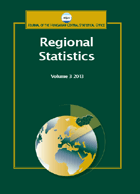Administrative, spatial and demographic changes
in Székelyland since the Treaty of Trianon to the present day
Administrative, spatial and demographic changes
in Székelyland since the Treaty of Trianon to the present day
Author(s): Tibor Elekes, Ferenc SzilágyiSubject(s): History, Social Sciences, Economy, Geography, Regional studies
Published by: Központi Statisztikai Hivatal
Keywords: Székelyland;administrative changes of towns; spatial structure; population processes;
Summary/Abstract: This study analysed the characteristics of the spatial organisation, spatial structure and population processes of Székelyland after the Treaty of Trianon. The purpose of the administrative reorganisation after World War I was unification. Between 1950 and 1968, transformation took place mirroring the political-ideological view of the time, often at the expense of the territorial units and centres created as a result of centuries of spatial development. The most significant change in the spatial structure during the early 20th century was the industrialisation that occurred between 1950 and 1989. In Székelyland, a contradictory socio-economic process in relation to other regions of Romania, began after 1990. The impact was smaller than that of the processes that had taken place under Communism. The population growth characteristic of the 20th century was replaced by a steady decline after 1990–1992.The natural population decline of the last three decades and the vigorous transformation have resulted in population decline in the millions. The rate of population decline is the strongest among the young and physically active age groups.
Journal: Regional Statistics
- Issue Year: 10/2020
- Issue No: 01
- Page Range: 120-132
- Page Count: 13
- Language: English

